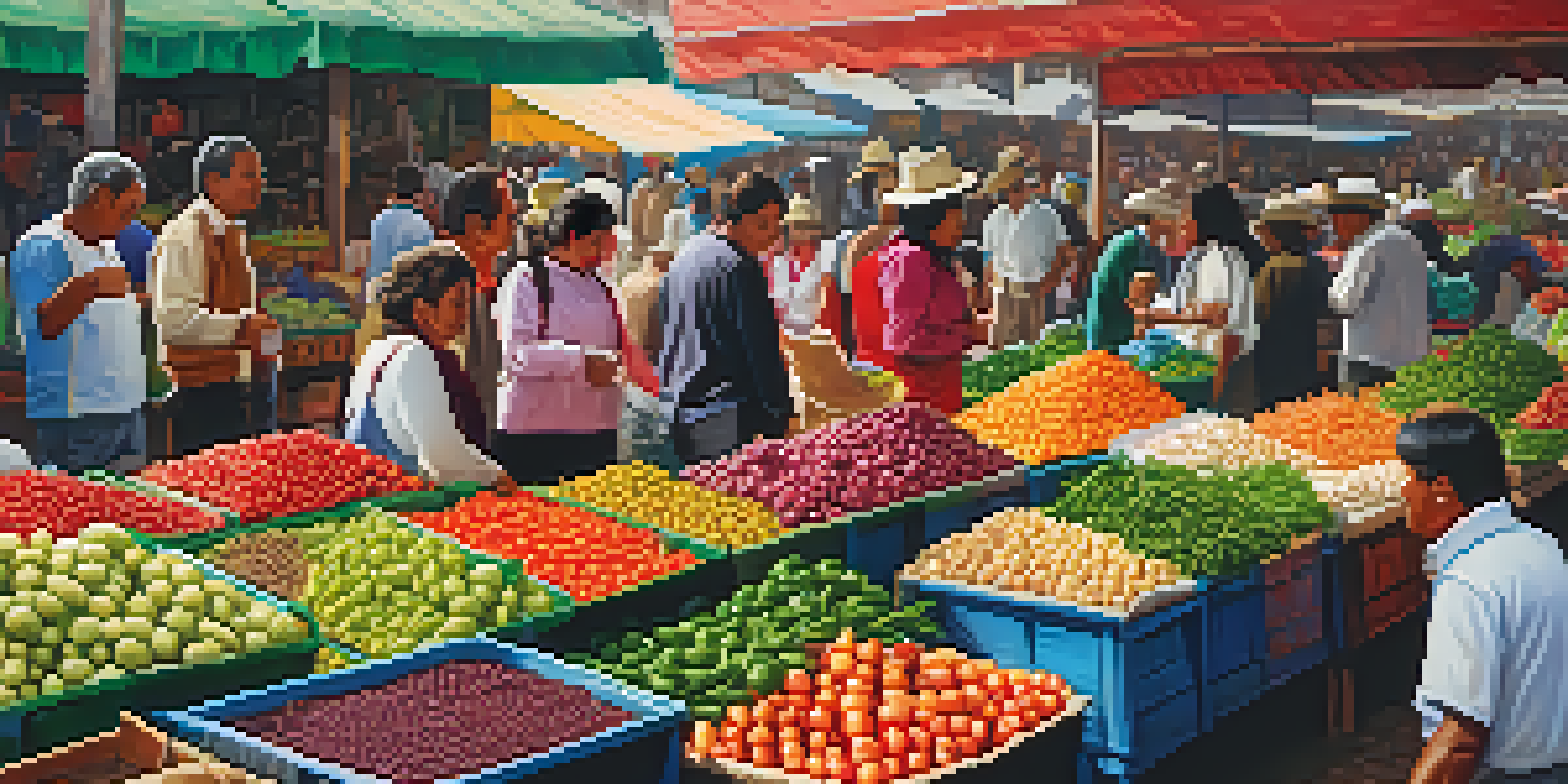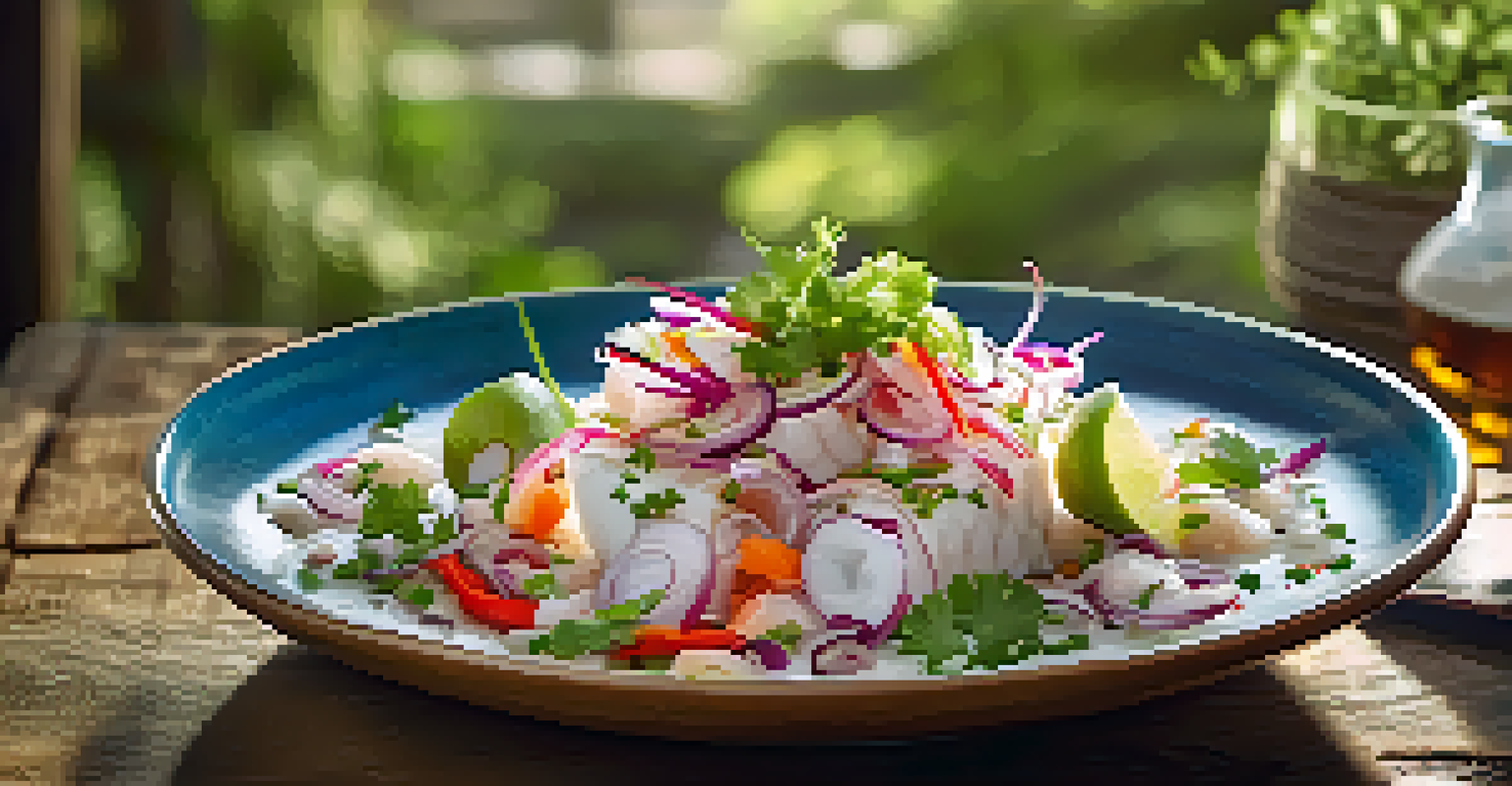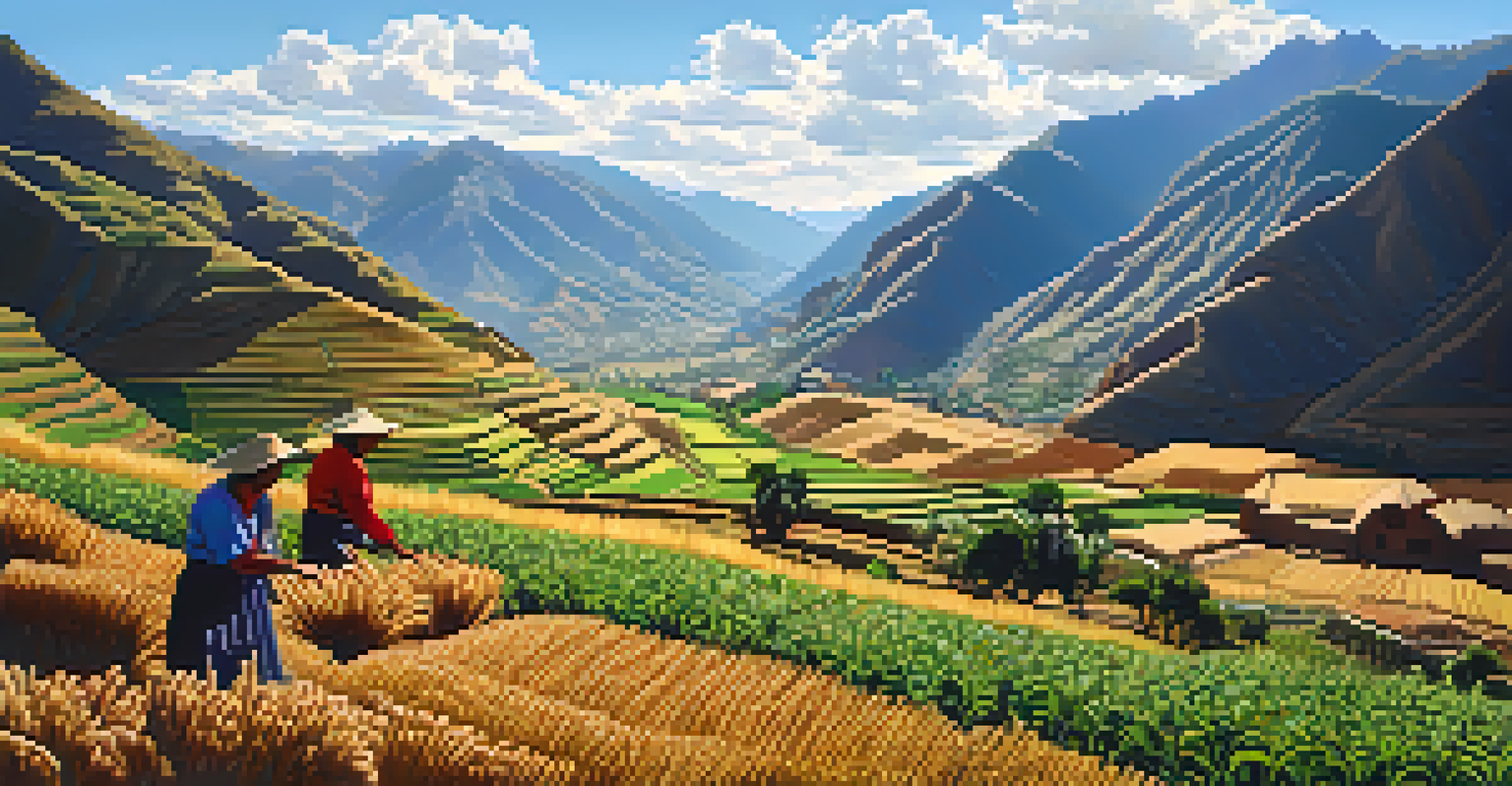Authentic Peruvian Ingredients: The Heart of Culinary Tourism

The Rich Tapestry of Peruvian Cuisine
Peruvian cuisine is a vibrant mix of flavors, colors, and textures, reflecting the country's diverse culture and geography. From the Andes to the Amazon, each region contributes unique ingredients that create a culinary tapestry unlike any other. This rich variety not only attracts food enthusiasts but also positions Peru as a leading destination for culinary tourism.
Food is a universal language that connects us all.
Imagine biting into a juicy piece of ceviche, where the freshness of the fish is perfectly complemented by the tang of lime and the kick of chili. This dish, simple yet profound, showcases how Peru's coastal offerings harmonize with its agricultural bounty, illustrating the country's commitment to high-quality, local ingredients. Culinary tourism in Peru invites travelers to explore these authentic tastes and the stories behind them.
As tourists delve into the local food scene, they uncover the history and traditions that shape each dish. Engaging with chefs and local markets, they learn about Peruvian ingredients like quinoa, potatoes, and aji peppers, which are not only staples but also integral to the cultural identity of the nation.
Key Ingredients That Define Peruvian Cuisine
At the heart of any culinary tourism experience in Peru are its key ingredients. Quinoa, often dubbed a superfood, is a staple grain that has been cultivated in the Andes for thousands of years. Its nutty flavor and nutritional benefits have made it popular worldwide, yet nothing compares to enjoying it in a traditional Peruvian dish prepared with care and authenticity.

Another essential ingredient is the diverse array of potatoes that Peru boasts—over 4,000 varieties! From the creamy yellow potatoes to the purple-skinned ones, each type offers a distinct flavor and texture. When paired with local meats or vegetables, they create comforting dishes that warm the soul and tell the story of Andean agriculture.
Peruvian Cuisine's Unique Diversity
Peruvian cuisine blends ingredients from various regions, reflecting its rich cultural and geographical diversity.
Let's not forget about aji peppers, which add that beloved kick to many Peruvian dishes. With varieties ranging from mild to fiery hot, they are the backbone of sauces like aji verde and the famous Peruvian rocoto relleno. These peppers not only enhance flavors but also connect diners to the vibrant markets where they are sold.
Exploring Regional Flavors in Peruvian Cuisine
Peru's geography plays a pivotal role in its culinary diversity. The coastal region is known for its seafood, while the highlands offer hearty grains and tubers. Each region showcases distinct flavors, making culinary tourism a journey through Peru's landscapes and history.
Eating is a necessity, but cooking is an art.
For instance, in the coastal cities like Lima, visitors can indulge in fresh ceviche and tiraditos, where the ocean's bounty meets zesty ingredients. Meanwhile, the highlands invite travelers to savor dishes like pachamanca, where meats and vegetables are slow-cooked underground, creating a unique flavor that connects with ancient traditions.
This regional exploration allows tourists to experience the essence of Peru. By sampling local specialties, they gain insights into the customs, festivals, and everyday life of the people, deepening their appreciation for Peruvian culture as they savor each bite.
The Role of Local Markets in Culinary Tourism
Local markets are the heartbeat of culinary tourism in Peru. They offer not just ingredients, but also an immersive cultural experience that showcases the country's culinary heritage. Strolling through bustling markets like Mercado de Surquillo in Lima, visitors are greeted by vibrant colors, inviting aromas, and the sounds of lively conversations.
These markets are treasure troves of fresh produce, spices, and traditional delicacies. Tourists can interact with local vendors, learn about their products, and even participate in cooking classes. This hands-on approach to learning about Peruvian ingredients fosters a deeper connection to the food and the culture that surrounds it.
Local Markets Enhance Culinary Tourism
Visiting local markets immerses tourists in Peru's culinary heritage, allowing them to connect with vendors and learn about traditional ingredients.
Moreover, shopping at these markets supports local economies and promotes sustainability. By choosing to buy fresh, locally sourced ingredients, travelers contribute to preserving Peru's culinary traditions and ensuring that the rich flavors of the country continue to thrive for generations to come.
The Influence of Cultural Heritage on Peruvian Food
Peruvian cuisine is a melting pot of influences, including Indigenous, Spanish, African, and Asian cultures, creating a unique culinary identity. This rich cultural heritage is evident in the way ingredients are combined and prepared, resulting in dishes that tell a story of migration and adaptation. Culinary tourism allows travelers to taste these narratives through authentic recipes passed down through generations.
For instance, the Peruvian dish lomo saltado reflects the fusion of Chinese stir-frying techniques with traditional ingredients like beef and potatoes. This blending of cultures highlights how Peru's culinary landscape evolves while still honoring its roots. Tourists who explore this aspect of food gain a deeper understanding of Peru's history and the resilience of its people.
As visitors savor these diverse flavors, they also engage with the communities that create them. By participating in cooking classes or food tours, they learn about the cultural significance of each ingredient, fostering a sense of appreciation for the stories behind their meals.
Sustainable Practices in Peruvian Culinary Tourism
Sustainability is becoming increasingly important in the world of culinary tourism, and Peru is making strides in this area. Many chefs and restaurants prioritize sourcing local ingredients, reducing their carbon footprint, and supporting sustainable farming practices. This shift not only enhances the quality of the food but also promotes environmental consciousness among tourists.
Participating in culinary tourism in Peru allows travelers to support initiatives that protect biodiversity and cultural heritage. For instance, many farms in the Sacred Valley focus on organic farming methods that preserve traditional crops and promote healthy ecosystems. Tourists who engage with these practices contribute to the preservation of Peru's unique culinary landscape.
Cultural Influences Shape Flavors
Peruvian food showcases a fusion of Indigenous, Spanish, African, and Asian influences, creating a unique culinary identity that tells the story of migration and adaptation.
Moreover, experiences that highlight sustainability, such as farm-to-table dining or eco-friendly cooking classes, allow visitors to learn about the importance of environmental responsibility. By understanding where their food comes from, tourists can make informed choices that positively impact both the local economy and the planet.
Conclusion: A Culinary Journey Through Peru
Embarking on a culinary journey through Peru is an invitation to explore the heart of its culture through its ingredients. From the vibrant markets to the diverse regional flavors, every experience offers a taste of authenticity that connects visitors to the land and its people. Culinary tourism in Peru is not just about food; it's about storytelling, heritage, and community.
As travelers savor each dish, they uncover the stories behind the ingredients and the traditions that shape them. This journey transforms a simple meal into a rich tapestry of experiences, allowing tourists to leave with not just memories but also a deeper understanding of Peru's cultural identity.

In a world where food is a universal language, Peru's culinary offerings speak volumes. By embracing the authentic ingredients and the stories they tell, culinary tourists contribute to the preservation of Peru's rich culinary heritage while enjoying a delicious adventure.